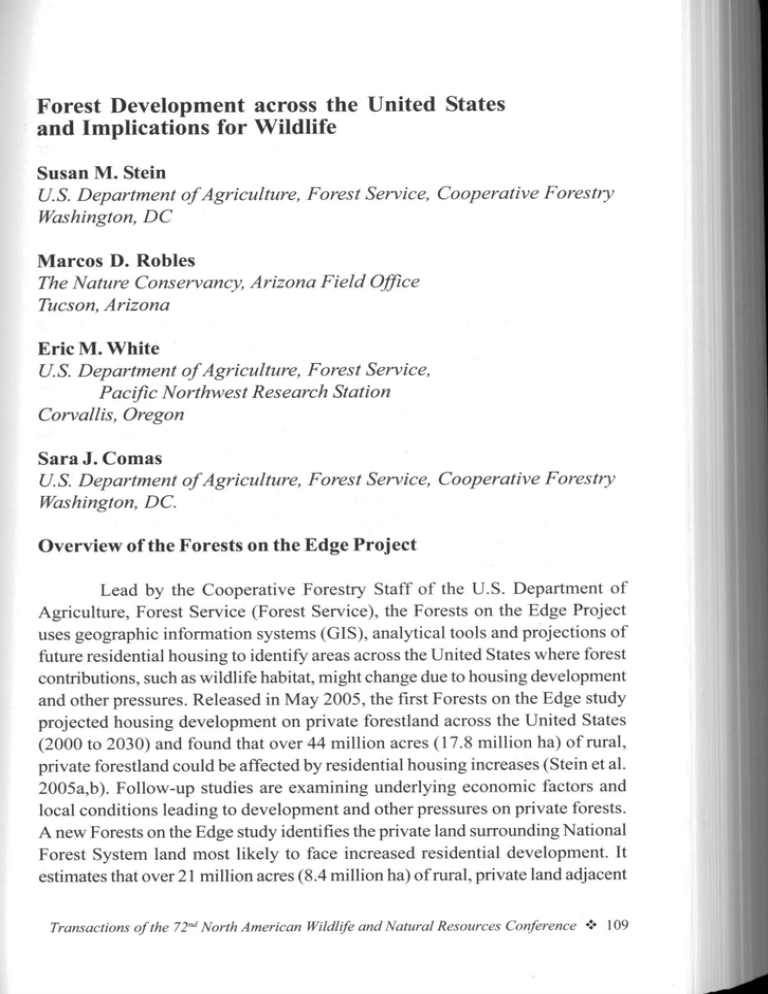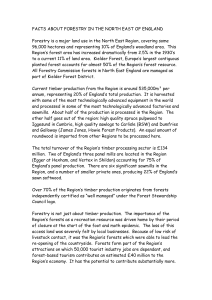Forest Development across the United States and Implications for Wildlife
advertisement

Forest Development across the United States and Implications for Wildlife Susan M. Stein U.S. Department ofAgriculture, Forest Service, Cooperative Forestry Washington, DC Marcos D. Robles The Nature Conservancy, Arizona Field Office Tucson, Arizona Eric M. White U.S. Department ofAgriculture, Forest Service, Pacific Northwest Research Station Corvallis, Oregon Sara J. Comas U.S. Department ofAgriculture, Forest Service, Cooperative Forestry Washington, DC. Overview of the Forests on the Edge Project Lead by the Cooperative Forestry Staff of the U.S. Department of Agriculture, Forest Service (Forest Service), the Forests on the Edge Project uses geographic information systems (GIS), analytical tools and projections of future residential housing to identify areas across the United States where forest contributions, such as wildlife habitat, might change due to housing development and other pressures. Released in May 2005, the first Forests on the Edge study projected housing development on private forestland across the United States (2000 to 2030) and found that over 44 million acres (17,8 million ha) of rural, private forestland could be affected by residential housing increases (Stein et al. 2005a,b). Follow-up studies are examining underlying economic factors and local conditions leading to development and other pressures on private forests. A new Forests on the Edge study identifies the private land surrounding National Forest System land most likely to face increased residential development. It estimates that over 21 million acres (8.4 million ha) of rural, private land adjacent Transactions of the 72'' North American Wildlife and Natural Resources Conference • 109 to national forests and grasslands will experience increased development between 2000 and 2030. This paper reviews each of these studies, as well as case studies, of selected areas and discusses their implications for at-risk species and other wildlife. Implications of Residential Development for Wildlife America's forests provide habitat for many wildlife species, including at-risk species. Housing development can reduce habitat, fragment remaining habitat into smaller, disjointed units, isolate wildlife species, inhibit wildlife movement and reduce the probability of recolonization in the event that a species disappears from a given patch of habitat (Theobald et al. 1997). Housing development is also associated with the removal and alteration of native vegetation as well as increased fencing. Each of these activities can impact the presence and movement of wildlife. Loss of forestland can lead to increased recreation on remaining forestlands, which, in turn, can cause some species to dicr ft livity, like feeding patterns (Theobald et al. 1997). Avian communities are especially sensitive to habitat fragmentation by ui[vin development. Fragmentation is considered to be a primary factor to neotropical migrant declines (Wear and Greis 2002). Several large field studies iave found a correlation between development and declines in species richness Engels and Sexton 1994). Private Forests under Future Development Pressures— National Assessment The purpose of the first Forests on the Edge study was to determine the and location of future development on private forests across the conterminous United States. Three housing-density categories were used for tIis purpose: 1. Rural I: 16 or fewer housing units per square mile 2. Rural II: 16 to 64 housing units per square mile 3. UrbanlExurban: more than 64 housing units per square mile. \tCIU Our analysis identified all rural forestland (i.e., land categorized as Rural I or Rural II) across the United States that is projected to experience increased 110 Session Two: Forest Development across the United States and Implications for.. I housing density. Results indicate that 44 million acres (17.8 million ha) of rural private forest will experience increased housing density from 2000 to 2030. The study also identified watersheds with the highest percent of land to experience forestland development; watersheds had to be at least 10 percent forested and had to have at least 50 percent of their forests in private ownership to qualify. As indicated in Figure 1, watersheds across the eastern United States and in parts of California and the Pacific Northwest are projected to experience the most extensive increases in forestland development. Figure 1. Watersheds in which housing density is projected to increase on private forests by 2030. High-risk Watersheds with At-risk Species Another Forests on the Edge study, entitled Private Assets/Public Benefits, involves ranking U.S. watersheds according to private-forest contributions and to threats to these contributions. The study identifies those watersheds where private forests are providing important resources, such as timber, clean water or at-risk species habitat, and that are most at-risk from future development, insect pests or air pollution. This paper will discuss an Transactions of the 72's" North American Wildlife and Natural Resources conference + 111 assessment of potential impacts of private-forest development on forest habitat for at-risk species. Data on at-risk species is provided by NatureServe and is based on a national assessment of at-risk species associated with private forestland in eight-digit watersheds across the conterminous United States. Note that the identification of at-risk species in this paper may be somewhat imprecise as it is based on coarse geographic analysis conducted on a national scale. Some of the species included in this analysis are freshwater or riparian species that do not occur directly on forestland but that are associated with and dependent upon healthy functioning forests. At-risk species descriptions throughout this paper are derived from information provided on the NatureServe Explorer Website (http://www.natureserve.org/explorer). The Forest Service used the results of this assessment to rank watersheds according to the number of at-risk species associated with private forest in each watershed. In order to be included in the map displayed in Figure 2, watersheds had to be at least 10 percent forested and had to have at least half of their forests in private ownership. Watersheds with the highest numbers of privateforest-associated, at-risk species are located in the southeastern United States, coastal California and the Pacific Northwest. Private forests in watersheds found in the upper 10" percentile are associated with up to 101 at-risk species. Next, the watersheds are ranked according to the percent of private forest projected to experience increased housing density (prepared using the same housing density categories described earlier in this paper). An overlay of these two layers produces a ranking of watersheds according to the presence of at-risk species and the percent of private forest to be developed. The results are displayed in Figure 3. Watersheds in the upper 10 11 percentile, where at-risk species' forest habitat is most likely to be affected by increased housing density, are scattered throughout the Southeast, New England, around the Great Lakes and along the West Coast. The highest ranked watershed is the Seneca Watershed, located in northwestern South Carolina and home to 66 globally ranked species, including Evan's Cheilolejeunea (Cheilolejeunea evansii), a liverwort ranked as critically imperiled (at a high risk of extinction) globally and within the three states where it occurs (South Carolina, North Carolina and Alabama). Also found in this watershed is the green salamander (Aneides aeneus), ranked as critically imperiled in South Carolina. The Powell Watershed, a long, slender watershed bordering Kentucky and Virginia and running down into Tennessee, is ranked second of all U.S. 112 + Session Two: Forest Development across the United States and Implications for I.Figure 2. Percentile rankings of watersheds with respect to at-risk species. L - - Figure 3. Percentile rankings of watersheds with respect to development threat to at-risk species. Transactions of the 72" North American Wildlife and Natural Resources Conference • 113 watersheds with respect to at-risk species found in private forests likely to experience development. Its forests provide habitat for close to 80 globally ranked species, including 21 listed as critically imperiled. Forests in this watershed also provide habitat for the red-cockaded woodpecker (Picoides borealis), which is critically imperiled in Kentucky. Private Forestland Development Case Studies The development of rural forestland is a result of market forces. As populations, incomes and economic growth increase, so do the demand for land and the financial incentives for landowners to sell land for development (Kline et al. 2004). Demands for residential development also increase with people's lifestyle choices when, for example, people relocate to rural areas or buy second homes in scenic forest settings. Increased housing is accompanied by an increase in land converted to commercial use and public infrastructure. In order to understand market forces responsible for increased development in selected watersheds, in-depth case studies were conducted in northwestern Washington, southern Maine and Georgia (White 2006 a, b). Summaries of the first two analyses are provided here. Watersheds studied in northwestern Washington include the Straight of Georgia, Nooksack, Lower Skagit, Stillaguamish and Snohomish watersheds (Figure 4). By 2030, an estimated 60,000 forestland acres (24,282 ha) in the Straight of Georgia Watershed alone are projected to experience increased residential development. Projections for the other watersheds range from 10,000 to 36,000 acres (4,04614,568 ha). A look at past trends indicates that these watersheds have experienced considerable increases in population and residential housing over the past decades largely due to positive net migration, i.e., people are moving into Washington from other states. Additional factors include declining stumpage values for Douglas fir (Pseudotsuga menziesii, a key timber species), steady-to-declining timber harvests and a high market value for undeveloped land. At-risk species that could be affected by an increase in forest development in the Northwest Washington case study watersheds include the tall bugbane (Actaea elata), considered vulnerable at the global and state level and ranked as critically imperiled in British Columbia. This vascular flowering plant species is limited to the Pacific Northwest; large populations are found in southern Oregon while smaller populations are scattered throughout western Oregon and Washington. 114 • Session Two: Forest Development across the United States and Implications for p Figure 4. Case study of northwestern Washington watersheds. Whaton county Lower S9fl county Staguanitr, Snoom psh county Sn The Maine case study focused on the Lower Penobscot and nearby watersheds in southcentral and southwestern Maine (Figure 5). Over 310,000 acres (125,452 ha) of forestland in the Lower Penobscot Watershed are projected to experience increases in housing density by 2030. Forestland acres projected to experience increased housing density in the other watersheds studied range from 84,800 to 213,800 acres (34,316-86,521 ha). A study of past trends indicates that both population and housing have been increasing in Maine and that a few towns in southern Maine experienced housing increases of over 40 percent in the 1990s (E. M. White, unpublished report 2006). The percentage increase in housing units (11 percent) was, in fact, far greater than the increase in population (4 percent). The area of timber harvested for land-use conversion has also been increasing (primarily on family-owned forests in southern Maine). Some of this increase is due to second-home construction. In fact, Maine has the highest percentage (16 percent) of housing units being used as second homes of any state. Average commute times have been increasing in parts of the state, including parts of our study area, suggesting that people are willing to commute farther to take advantage of the area's natural amenities, lower housing costs and lower taxes. The Maine case study watersheds average roughly 13 at-risk species, including the small-whorled pogonia (Isotria medeoloides) and the hessel's hairstreak (Callophrys hesseli). The small-whorled pogonia is a member of Transactions of the 72 d North American Wildlife and Natural Resources Conference • 115 I Figure 5. Case study of Maine watersheds. , A A ( Lower Penobscot Lower Keruwbec LDwe1Androscoggin '•) - Preeuinpcot t t' St George-Sheepacot / • ., = "- the orchid family and is considered imperiled on a global scale. This species typically makes its home in deciduous or deciduous-coniferous forests. The primary threat to this species is habitat destruction for residential or commercial development or forestry. Other threats, such as herbivory, recreational use of habitat and inadvertent damage from researcher activities, have also been identified. The hessel's hairstreak is a small butterfly in the Lycaenidae family and is considered vulnerable on the global scale. The hairstreak butterfly typically inhabits cedar swamps. There are significant threats from habitat loss and suppression of cedar reproduction by deer in parts of its range. Well managed patchy logging is not considered a long-term threat, since species can recolonize, but development and biocide spraying are also threats to the population. National Forests on the Edge The purpose of the final study discussed in this paper, National Forests on the Edge, is to identify national forests and grasslands (lands managed by the Forest Service) adjacent to rural, private lands likely to experience a substantial increase in housing development. The study ranks the national forests and grasslands according to the percentage of adjacent, rural, private land (forest and nonforest) projected to experience increased development (again using the definitions provided at the beginning of this paper). In total, housing development 116 • Session Two: Forest Development across the United States and Implications for I is projected to increase on about 21 million acres (8.4 million ha) of rural, private land surrounding national forests and grasslands scattered across the country (from 2000 to 2030). A national map depicting these forests is still in production and is not included here but will be available in a future report. The Bitterroot Forest in Montana and Idaho is one of the national forests with the highest percentage of surrounding land projected to experience increases in housing density—close to 50 percent of the land found within 3 miles (4.8 km) of its borders is projected to experience increased housing density. Much of this land is located within current elk and mule deer winter range (see Figure 6). A -- L(4 -t tMSt. We •- Fi gure 6. Land surrounding the Bitterroot National Forest (Montana and Idaho) projected to experience increases in housing density from 2000(a) to 2030(h). Summary and Conclusions Across the country, rural forestland is being developed, with likely consequences for at-risk species and other wildlife. Geographic information system technology is making it possible to identify areas where impacts to wildlife from projected future development may be greatest. This paper has presented Transactions of the 72'° North American Wildlife and Natural Resources Conference • 117 three studies that can be used as examples for examining residential development in rural landscapes.Housing density projections can be combined with forestvegetation data to locate areas where forestland is most likely to experience increased development. This data, in turn, can be combined with-wildlife data, such as the NatureServe at-risk spéciesdatabase, to identify areas of potentially high wildlife impact. Lands prote&ed from development, such a National Forest Ss'ten'i land 'managed by the Forest Service, can-be assessed to determine where they-are most vulnerable to increased housing development along their boiders. Each of the assessments described here required nationally consistent data, which, as with most national data, is somewhat coarse and imprecise for use at the local level. The results of this data are, therefore, best used to inform broad policy analysis, to highlight areas of potential concern and to identify opportunities for further study. As with most federal data, much of the Forests on the Edge data are available for use by others. We have responded to many requests for the data from the first Forests on the Edge report. Numerous groups, including universities, conservation organization and consulting firms, have used this data, alone or in combination with other GIS data, to support regional and statewide assessments. The Forest Service will continue its assessments of public and private forests and will look forward to making Forests on the Edge data available for public use. More information on Forests on the Edge can be found on http:// www.fs.fed.us/projectSifote. Reference List - Engels, T., C. Sexton. 1994. Negative correlation of blue jays and golden-cheeked rblers near an urbanizing ar ea.' Conservation Biologi. 8:286-90. Kline, J. D., R. J. Alig, B. Garber-Yonts. 2004. Forestland social values and open space preservation. Journal of Forestry. 102(8):39_45. Stein, S. R. E. McRoberts, M. D. Nelson, D. M. Theobald, M. Eley, and M. Dechter. 2005a. Forests on the edge: A GIS-based approach to projecting housing development on private forests. In Monitoring science and technology symposium Unifying knowledge for sustainability in the Western Hemisphere. RMRS . P-37cD, eds. C. Aguirre-Bravo, P. • , 4- I .4-.JP'.... - 118 •• Session Two: Forest Development across the United States and Implications for J. Pellicane, D. P. Burns, and S. Draggan, 736-43. U.S. Department of Agriculture, Forest Service, Rocky Mountain Research Station: Fort Collins, CO. Stein, S., R. E. McRoberts, R. J. Alig, M. D. Nelson, D. M. Theobald, M. Eley, • M, Dechter, and M. Carr. 2005b, Forests on the edge: Housing development on America 's private forests, general technical report PNW-GTR-636. U.S. Department ofAgriculture, Forest Service, Pacific Northwest Research Station: Portland, OR. Stein, S. M., R. E. McRoberts, D. Meneguzzo, S. Comas, M. Hatfield, X. Zhou, J. Millsm, M. Eley, G. Liknes, J. W. Coulston, M. Dechter, K. Riitters, M. Robles, and F. Krist, Jr. 2008. Threats to Private Forest Lands in the USA: A Forests on the Edge Study. http://www.forestencyclopedia.net' p/p36l3. Stein, 5; R. J. Alig, E. M. White, S. Comas, M. Carr, M. Eley, K. Elverum, M. O'Donnell, D. M. Theobald, K. Cordell, J. Haber, and T. Beauvais. 2007. National Forests on the Edge. Development Pressures on America 's national forests and grasslands. U.S. Department of Agriculture, Forest Service: Portland, Oregon. Theobald, D. M., J. R. Miller, and N. T. Hobbs. 1997. Estimating the cumulative effects of development on wildlife habitat. Landscape and Urban Planning. 39:25-36. Wear, D. N., and J. G. Greis, eds. 2002a. Southern forest resource assessment, general technical report SRS-53. U.S. Department of Agriculture, • Forest Service, Southern Research Station: Asheville, NC. White, E. M. 2006b. Forests on the Edge: A case study of south-central and southwestern Maine watersheds. U.S. Department of Agriculture, Pacific Northwest Research Station. http://www.fs.fed.us/projects/fote/ cases/maine-casestudy-ew-062506.pdf. Transactions of the 72" North American Wildlife and Natural Resources Conference + 119




